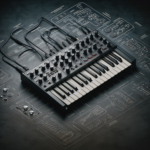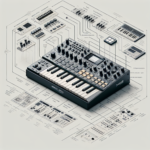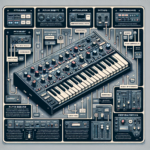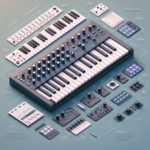Korg MicroKey 61: Comprehensive Guide to Features, Setup, and Performance

Introduction
The Korg MicroKey 61 is a versatile MIDI controller designed to meet the needs of both amateur and professional musicians. With its compact design and robust feature set, it aims to provide a seamless experience for music production, live performances, and studio sessions. Targeted at musicians, producers, and DJs, the MicroKey 61 offers a balance of portability and functionality, making it a popular choice in the music industry.
Korg, a renowned name in the world of musical instruments and equipment, has a long-standing reputation for producing high-quality, innovative products. Known for their synthesizers, digital pianos, and MIDI controllers, Korg continues to be a trusted brand among musicians worldwide.
Key Features Overview:
- 61 velocity-sensitive keys
- Compact and lightweight design
- USB-powered
- Compatible with major DAWs
- Octave shift buttons
- Pitch bend and modulation wheels
- Assignable knobs and buttons
Design and Build Quality
Physical Design
The Korg MicroKey 61 boasts a sleek and modern design, featuring 61 velocity-sensitive keys that provide a responsive and expressive playing experience. The controller measures approximately 850mm in length, 139mm in width, and 54mm in height, making it compact enough to fit into most studio setups without taking up too much space. Weighing in at just 2.1 kg, it is lightweight and easy to handle.
Portability
One of the standout features of the MicroKey 61 is its portability. Its compact size and lightweight design make it easy to transport, whether you’re heading to a gig, a studio session, or simply moving it around your home studio. The USB-powered functionality eliminates the need for an external power supply, further enhancing its portability.
Durability
Despite its lightweight design, the MicroKey 61 is built to last. The keys are sturdy and responsive, and the overall build quality is solid. The materials used in its construction are durable, ensuring that the controller can withstand regular use without showing signs of wear and tear.
Setup and Configuration
Initial Setup
Setting up the Korg MicroKey 61 is a straightforward process. Follow these steps to get started:
- Unbox the controller and connect it to your computer using the provided USB cable.
- Ensure that your computer recognizes the device. Most modern operating systems will automatically detect and install the necessary drivers.
- Open your preferred DAW and configure the MIDI settings to recognize the MicroKey 61 as an input device.
Software Installation
While the MicroKey 61 is designed to be plug-and-play, you may need to install additional software to unlock its full potential. Korg provides a software bundle that includes the Korg KONTROL Editor, which allows you to customize the controller’s settings and MIDI mappings. To install the software:
- Visit the Korg website and navigate to the MicroKey 61 product page.
- Download the Korg KONTROL Editor and any other relevant software.
- Follow the on-screen instructions to install the software on your computer.
Compatibility
The Korg MicroKey 61 is compatible with a wide range of operating systems and DAWs. It works seamlessly with Windows and macOS, and is compatible with popular DAWs such as Ableton Live, FL Studio, Logic Pro, and Cubase. Additionally, it can be used with various software instruments and plugins, making it a versatile tool for music production.
Features and Functionality
Key Features
The MicroKey 61 is packed with features that enhance its functionality and usability:
- 61 Velocity-Sensitive Keys: The keys are responsive and provide a natural playing experience, making it suitable for both beginners and experienced musicians.
- Pitch Bend and Modulation Wheels: These wheels allow for expressive control over pitch and modulation, adding depth to your performances.
- Octave Shift Buttons: Easily shift the octave range of the keyboard to access a wider range of notes.
- Assignable Knobs and Buttons: Customize the controller to suit your workflow by assigning functions to the knobs and buttons.
Customizability
The Korg KONTROL Editor software allows users to customize the MicroKey 61 to their liking. You can assign different MIDI functions to the knobs and buttons, create custom MIDI mappings, and save your settings for different projects. This level of customizability ensures that the controller can adapt to your specific needs and workflow.
Unique Functions
One of the unique features of the MicroKey 61 is its arpeggiator function. This allows you to create complex arpeggios with ease, adding a new dimension to your music. Additionally, the controller includes a sustain pedal input, which is not commonly found on other MIDI controllers in this price range.
Integration with DAWs
The MicroKey 61 integrates seamlessly with popular DAWs, providing a smooth and efficient workflow. In Ableton Live, for example, you can use the controller to trigger clips, control parameters, and navigate your project. In FL Studio, the controller can be used to play virtual instruments, control automation, and more. The integration is intuitive and enhances the overall user experience.
Advanced Features
For advanced users, the MicroKey 61 offers features such as aftertouch, which allows for additional expression by applying pressure to the keys after they have been pressed. The controller also includes a chord mode, which enables you to play complex chords with a single key press. These advanced features make the MicroKey 61 a powerful tool for music production and performance.
Performance
Latency and Responsiveness
The MicroKey 61 performs exceptionally well in terms of latency and responsiveness. The keys are sensitive and responsive, providing a natural playing experience. The controller’s low latency ensures that there is no noticeable delay between pressing a key and hearing the sound, making it suitable for both studio recording and live performances.
Real-World Usage
In practical scenarios, the MicroKey 61 excels. Whether you’re using it in a studio setting for music production or on stage for live performances, the controller delivers consistent and reliable performance. Its compact size and lightweight design make it easy to transport, while its robust feature set ensures that you have all the tools you need at your fingertips.
User Experience
User feedback for the MicroKey 61 has been overwhelmingly positive. Users appreciate its portability, ease of use, and customizable features. The controller’s integration with popular DAWs and software instruments has also been praised, as it enhances the overall workflow and user experience.
Applications and Use Cases
Beginner vs. Professional Use
The Korg MicroKey 61 is suitable for both beginners and professionals. Its intuitive design and user-friendly features make it accessible for beginners, while its advanced features and customizability cater to the needs of professional musicians and producers.
Studio Use
In a studio environment, the MicroKey 61 is a valuable tool for music production and recording. Its responsive keys and customizable controls make it easy to play virtual instruments, control automation, and navigate your projects. The controller’s compact size also ensures that it fits comfortably into most studio setups.
Live Performance
The MicroKey 61 performs exceptionally well in live settings. Its portability and lightweight design make it easy to transport to gigs, while its robust feature set ensures that you have all the tools you need for a successful performance. The controller’s low latency and responsive keys make it a reliable choice for live musicians.
Specific Genres
The MicroKey 61 excels in a variety of music genres, including EDM, hip-hop, and classical. Its versatile feature set and customizable controls make it suitable for creating complex electronic music, while its responsive keys and expressive controls make it ideal for classical compositions.
Pros and Cons
Pros:
- Compact and lightweight design
- Responsive and velocity-sensitive keys
- Customizable controls
- Seamless integration with popular DAWs
- Advanced features such as aftertouch and chord mode
- USB-powered for easy setup and portability
Cons:
- Limited number of assignable knobs and buttons
- No built-in display for visual feedback
- May require additional software installation for full functionality
Common Issues and Troubleshooting
Known Issues
While the MicroKey 61 is generally well-received, some users have reported issues such as occasional connectivity problems and difficulty with software installation. These issues are relatively rare and can often be resolved with troubleshooting.
Troubleshooting Tips
- Connectivity Issues: Ensure that the USB cable is securely connected and try using a different USB port on your computer.
- Software Installation: Make sure that you have downloaded the latest version of the software from the Korg website and follow the installation instructions carefully.
- MIDI Mapping: If you encounter issues with MIDI mapping, refer to the Korg KONTROL Editor manual for guidance on customizing your settings.
Customer Support
Korg offers reliable customer support for the MicroKey 61. Users can access support through the Korg website, where they can find FAQs, user manuals, and contact information for technical assistance. The brand’s customer support team is known for being responsive and helpful, ensuring that users can resolve any issues they encounter.
Comparisons with Similar Controllers
Competitor Comparison
When compared to similar MIDI controllers from other brands, the Korg MicroKey 61 holds its own. For example, the Akai MPK261 offers more assignable controls and a built-in display, but it is also larger and heavier. The Novation Launchkey 61 provides seamless integration with Ableton Live, but may not offer the same level of customizability as the MicroKey 61.
Feature Comparison
The MicroKey 61 stands out for its compact design, portability, and advanced features such as aftertouch and chord mode. While it may have fewer assignable controls compared to some competitors, its customizable settings and seamless DAW integration make it a strong contender in the MIDI controller market.
Conclusion
Summary
The Korg MicroKey 61 is a versatile and reliable MIDI controller that offers a balance of portability, functionality, and customizability. Its responsive keys, advanced features, and seamless integration with popular DAWs make it a valuable tool for both beginners and professional musicians.
Who Should Buy This?
The MicroKey 61 is ideal for musicians, producers, and DJs who need a portable and versatile MIDI controller. Its user-friendly design makes it accessible for beginners, while its advanced features cater to the needs of professionals. Whether you’re working in a studio or performing live, the MicroKey 61 is a reliable choice.
Final Thoughts
Overall, the Korg MicroKey 61 is a well-rounded MIDI controller that delivers on its promises. Its compact design, responsive keys, and customizable features make it a valuable addition to any musician’s toolkit. With its reliable performance and seamless DAW integration, the MicroKey 61 is a worthy investment for anyone looking to enhance their music production and performance capabilities.
FAQ
Is the Korg MicroKey 61 compatible with my DAW?
Yes, the MicroKey 61 is compatible with most major DAWs, including Ableton Live, FL Studio, Logic Pro, and Cubase.
Do I need to install any software to use the MicroKey 61?
While the MicroKey 61 is designed to be plug-and-play, installing the Korg KONTROL Editor software allows you to customize the controller’s settings and MIDI mappings.
Can I use the MicroKey 61 with my iPad?
Yes, the MicroKey 61 can be used with an iPad using a USB camera adapter. This allows you to connect the controller to your iPad and use it with compatible music apps.
Does the MicroKey 61 have aftertouch?
Yes, the MicroKey 61 includes aftertouch, allowing for additional expression by applying pressure to the keys after they have been pressed.
Is the MicroKey 61 suitable for live performances?
Yes, the MicroKey 61 is suitable for live performances. Its compact size, lightweight design, and robust feature set make it a reliable choice for live musicians.
Where to Buy
The Korg MicroKey 61 can be purchased from various retailers, including major music stores and online marketplaces. Some of the well-known retailers that carry this product include Guitar Center, Sweetwater, and Amazon. Be sure to check for availability and pricing at your preferred retailer.




